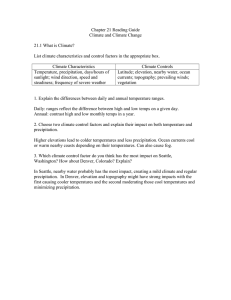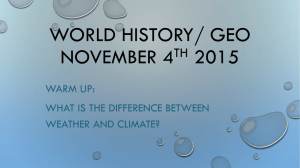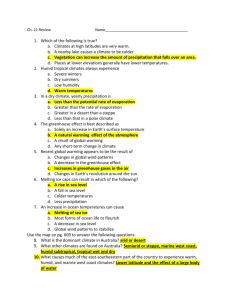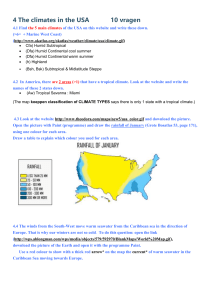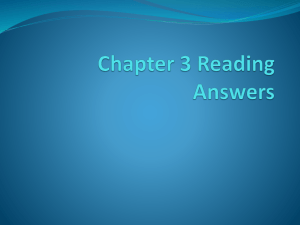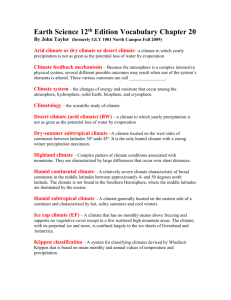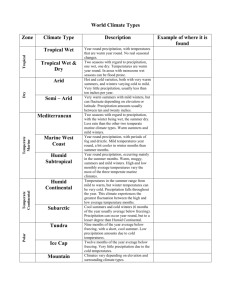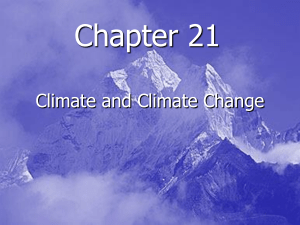Chapter 21 Worksheets
advertisement
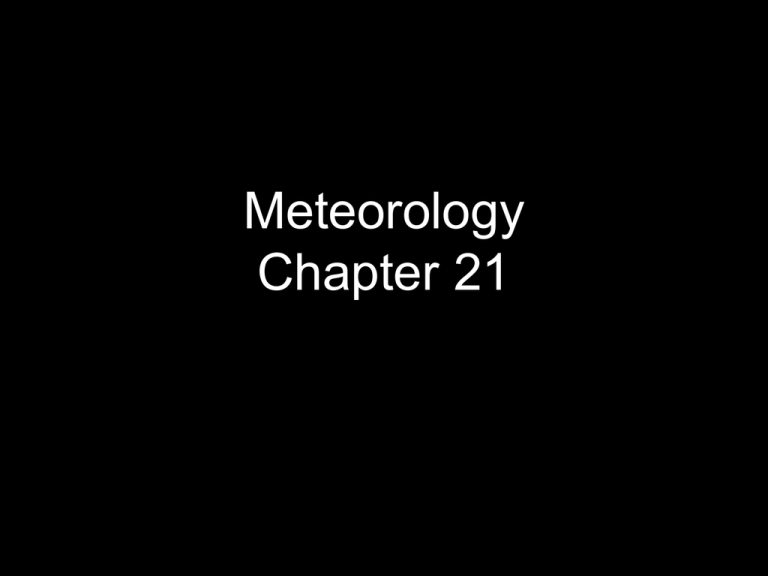
Meteorology Chapter 21 21.1 What is Climate? While You Read List climate characteristics and control factors in the appropriate box. Climate Characteristics Climate Controls Temperature; precipitation; days/hours of sunlight; wind direction, speed, and steadiness; frequency of severe weather. Latitude; elevation; nearby water; ocean currents; topography; prevailing winds; vegetation 21.1 After You Read 1. Explain the difference between daily and annual temperature ranges. Daily temperature ranges reflect difference between high and low on a given day while annual ranges contrast high and low monthly temperatures in a year. 21.1 After You Read 2. Choose two climate control factors and explain their impact on both temperature and precipitation. Higher elevations lead to colder temperatures and less precipitation. Ocean currents cool or warm nearby coasts, depending on their temperature. They can also cause fog. 21.1 After You Read 3. Which climate control factor do you think has the most impact on Seattle, Washington? How about Denver, Colorado? Explain. In Seattle, nearby water probably has the most impact, creating a mild climate and regular precipitation. In Denver, elevation and topography might have strong impacts, with the first causing cooler temperatures and the second moderating those cool temperatures and minimizing precipitation. 21.2 Climate Zones While You Read Polar Dry a) Sub climates Tundra, icecap b) Location At poles a)Sub climates Desert, semiarid b) Location Leeward side of mountains, horse latitudes c) Features c) Features Little precipitation, minimal or High temps. With cold nights, evaporation exceeds precipitation, no vegetation plant and animal life adapted to dryness Humid Tropical Moist mid-latitude a) Sub climates Tropical wet; tropical wet/dry a)Sub climates Severe winters; humid continental, sub-arctic/mild winters; humid subtropical, marine west coast, Mediterranean b) Location Close to equator and in ITCZ b) Location Severe winters: interiors and eastern coasts of continents, close to poles; mild winters: along water at edges of continents c) Features Hot/rainy year round; hot with wet and dry seasons; tropical rain forests and grasslands c) Features: severe winters: cold winters, hot/humid summers except in sub-arctic; mild winters: hot, muggy or cool summers depending on coastal position, and mild winters with mostly rain. 21.2 After You Read Describe the Highland climate zone and explain how it is different from the other main zones. The Highland climate zone occurs in mountainous areas and its features vary with the influence of latitude and elevation. It differs from the other zones within the same general location. 21.3 Climate Change While You Read 1. Earth’s motions 2. Plate tectonics Changes in the shape of Earth’s orbit, the tilt of its axis, and the axis of its rotation affect the intensity of the seasons. Changes in continent position affect wind patterns, ocean currents, and solar radiation absorption, creating global cooling 21.3 Climate Change While You Read 3. Sunspots Changes in sunspots on the Sun’s surface alter the amount of solar energy reaching the Earth. 4. Volcanoes Individual eruptions can cool temperatures by blocking solar energy with their debris, but repeated or extensive eruptions can warm temperatures by raising atmospheric carbon dioxide. 21.3 Climate Change While You Read 5. Human activities Deforestation and fossil fuel burning increase carbon dioxide levels and warm temperatures. 21.3 Climate Change After You Read List and describe a method that scientists use to study climate changes. Changes in sea-floor sediments indicate changes in water temperature and degree of glaciation over time. Changes in the oxygen features of glacial ice indicate variations in temperature during formation. Number of growth rings indicates age of trees and likely climate conditions each year.
